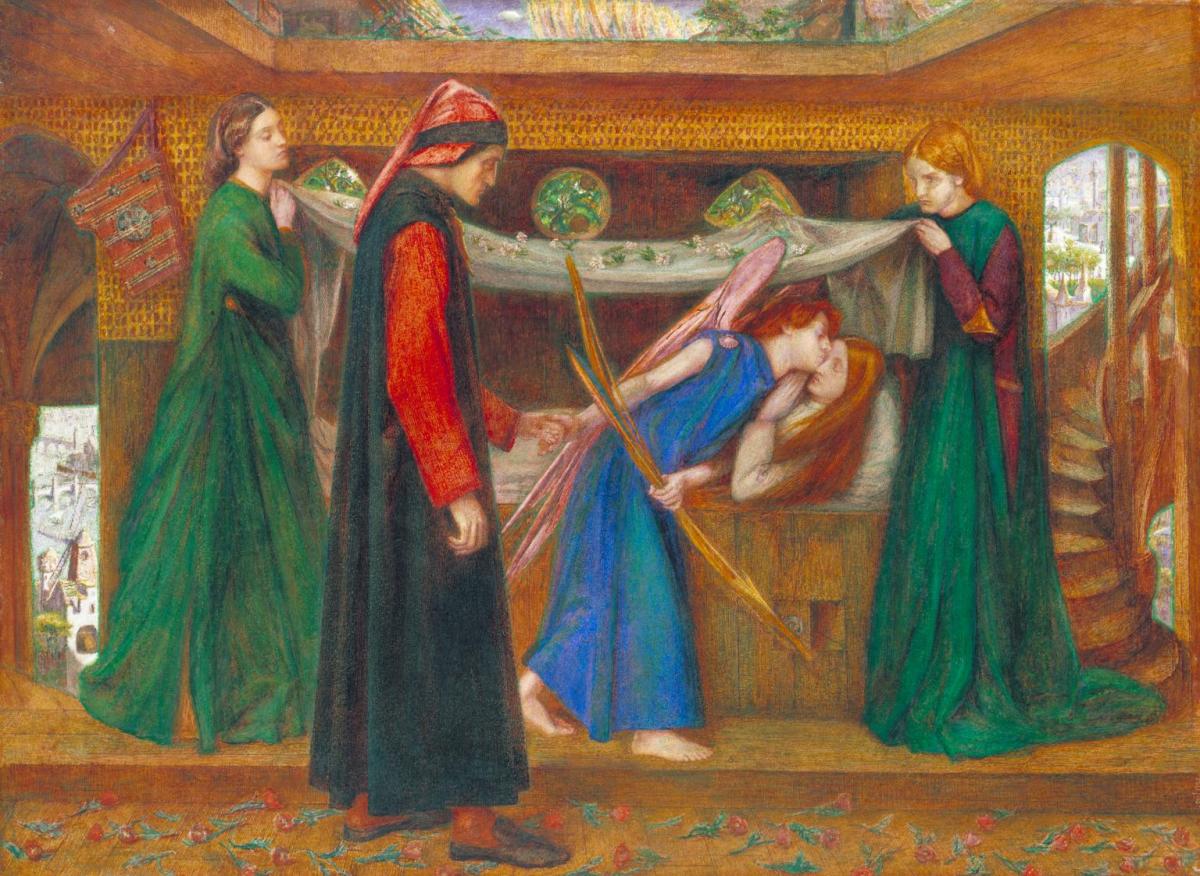Dante’s Dream at the Time of the Death of Beatrice is an oil on canvas painting created by Dante Gabriel Rossetti, a member of the Pre-Raphaelite Brotherhood, in 1856. This painting highlights a woman laying down on a bed, who seems to be deceased. As seen in the title, the viewer can assume that this must be Beatrice. To the right and left of Beatrice, there are two women standing and holding a cloth above Beatrice and what seems to be an angel, as she has wings on her back and is holding a bow and arrow. These two women holding the cloth are dressed similarly as they are both wearing long, loose, green dresses, giving context that they might have a similar role in the painting. Rossetti is specific on the color green for these women as this important color is known to symbolize hope, tranquility, and good fortune, which he is portraying towards the deceased Beatrice. As previously mentioned, leaning in towards Beatrice is what appears to be an angel, as the woman has wings on her back and is holding a bow and arrow in her left hand while her right is being accompanied by a man in black. The angel is in a blue dress, symbolizing a calming figure, and is leaning in to give Beatrice a kiss. What is interesting with the angel is she is in a very awkward position trying to accompany Beatrice on her death bed. As previously mentioned, one of the angel’s hand is being held by a man in black and the other is holding a bow and arrow. Since both of the angel’s hands are full, she has no ability to truly get in a comfortable position to pay her respects, especially since she almost seems to be pulled away by the man in black. Using context from the title, it can be assumed that the man in black is Dante. Rossetti dresses the man in black to symbolize death. He uses the color black specifically on the man because he is the main character in his dream, so it would make sense that he would symbolize the overall theme of the painting.
As we can see, Dante’s Dream at the Time of the Death of Beatrice is a true piece of Pre-Raphaelite artwork. As mentioned, the use of bright and other specific colors to create complex symbols is a key component of Pre-Raphaelite artwork. In addition to the luminant colors and complex symbols, Rossetti incorporates an abundance of detail in this painting. For example, the facial expressions of each individual in the painting are important to notice. The two women dressed in green to the left and right of Beatrice are expressing sorrow emotions, a sign of sympathy towards Beatrice. The angel also seems to be expressing sympathy towards Beatrice as she leans in the give her a kiss, however, there seems to be a sense of hesitation that is seen through the angel’s awkward body position. Lastly, and probably most importantly, is the man in black (Dante) who seems to have frustrated and upset facial expressions. The two factors of the colors Dante is wearing and his facial expressions can tell the viewer that he is clearly hurt from this death of Beatrice. The viewer can maybe assume that Beatrice might have been a woman he loved but never got the opportunity to show or tell her. This assumption can also be supported through the red roses spread throughout the floor near Dante’s feet, which symbolize love. The attention to detail Rossetti displays in his paintings are important to consider, as they all have meaning towards a bigger idea. Moreover, we see a spiral staircase to the right of the painting that seems to go going upward, however, we do not see where it leads to. Since Pre-Raphaelite Brotherhood artists such as William Holman Hunt and Rossetti incorporated many religious references in their painting, the viewer could possibly assume that maybe that is a staircase to heaven for Beatrice. Once again, the abundance of detail from the facial expressions to the specific colors chosen, as well as the religious connotations in the painting are all key features of Pre-Raphaelite artwork.


